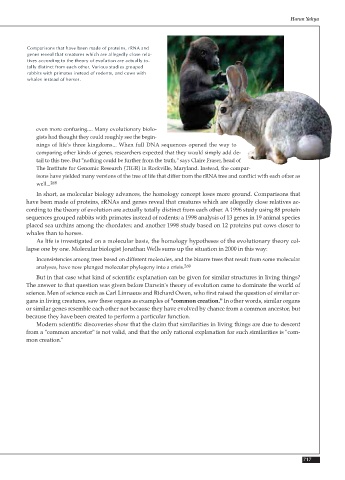Page 719 - Atlas of Creation Volume 2
P. 719
Harun Yahya
Comparisons that have been made of proteins, rRNA and
genes reveal that creatures which are allegedly close rela-
tives according to the theory of evolution are actually to-
tally distinct from each other. Various studies grouped
rabbits with primates instead of rodents, and cows with
whales instead of horses.
even more confusing.... Many evolutionary biolo-
gists had thought they could roughly see the begin-
nings of life's three kingdoms... When full DNA sequences opened the way to
comparing other kinds of genes, researchers expected that they would simply add de-
tail to this tree. But "nothing could be further from the truth," says Claire Fraser, head of
The Institute for Genomic Research (TIGR) in Rockville, Maryland. Instead, the compar-
isons have yielded many versions of the tree of life that differ from the rRNA tree and conflict with each other as
well... 268
In short, as molecular biology advances, the homology concept loses more ground. Comparisons that
have been made of proteins, rRNAs and genes reveal that creatures which are allegedly close relatives ac-
cording to the theory of evolution are actually totally distinct from each other. A 1996 study using 88 protein
sequences grouped rabbits with primates instead of rodents; a 1998 analysis of 13 genes in 19 animal species
placed sea urchins among the chordates; and another 1998 study based on 12 proteins put cows closer to
whales than to horses.
As life is investigated on a molecular basis, the homology hypotheses of the evolutionary theory col-
lapse one by one. Molecular biologist Jonathan Wells sums up the situation in 2000 in this way:
Inconsistencies among trees based on different molecules, and the bizarre trees that result from some molecular
analyses, have now plunged molecular phylogeny into a crisis. 269
But in that case what kind of scientific explanation can be given for similar structures in living things?
The answer to that question was given before Darwin's theory of evolution came to dominate the world of
science. Men of science such as Carl Linnaeus and Richard Owen, who first raised the question of similar or-
gans in living creatures, saw these organs as examples of "common creation." In other words, similar organs
or similar genes resemble each other not because they have evolved by chance from a common ancestor, but
because they have been created to perform a particular function.
Modern scientific discoveries show that the claim that similarities in living things are due to descent
from a "common ancestor" is not valid, and that the only rational explanation for such similarities is "com-
mon creation."
717

